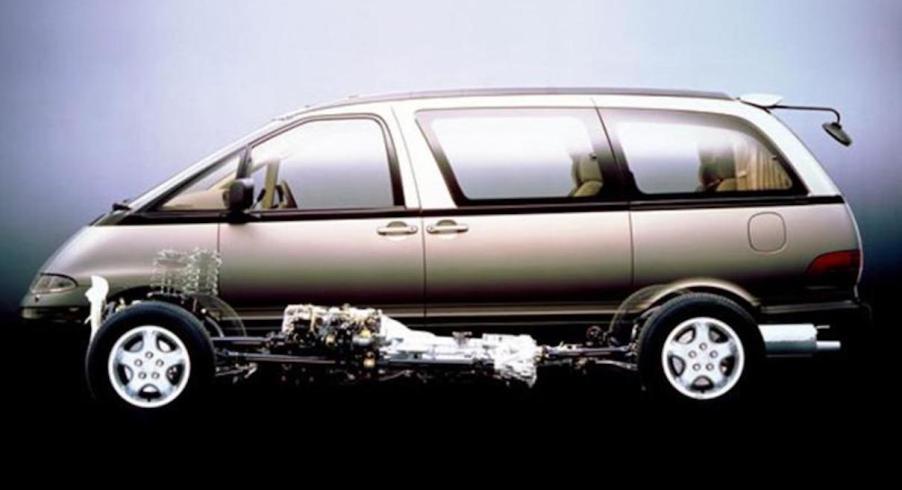
Toyota Previa: The Mid-Engine Supercar (Sort Of) That Was Also a Van
Toyota wanted to pull out all of the stops to develop its first real minivan, the Previa. But looking like an Easter egg on wheels, even down to the colors available, nobody saw the best part. Hiding under the smooth bodywork was a mid-engine setup. Toyota took an inline four-cylinder engine and laid it down to best be able to cover with a floor. This gave the Previa an excellent weight ratio and a lower center of gravity. Plus, there was more space inside.
Why did Toyota build the Previa minivan?

The minivan zeitgeist only got started in the mid-1980s, with Chrysler’s Dodge Caravan and Plymouth Voyager minivans. Before that, there had been only full-size commercial vans. This is in spite of minivan development attempts earlier at Ford.
But once the buyers started flocking to Dodge and Plymouth stores to snatch them up, all of the other auto manufacturers dove in as quickly as they could. That included Toyota. These were wonderfully practical vehicles, especially for young families. But they were boring, really boring.
What else was innovative about the Toyota Previa minivan?

What’s worse is that most of the other automakers’ attempts looked similar to Chrysler’s first. Obviously, Toyota took a different approach, starting with the soft, rounded body surfaces and the expanse of glass. Like the Goodyear blimp, with lots of windows.
That’s the visual that set the Previa apart from the rest of the minivan pack. But up to then, all vans had their engines placed between the passenger and driver’s seat. A big box hid the engine with pockets for drinking cups and maps, with lots of insulation underneath.
Full-size vans throughout the late-1960s and 1970s were rear-wheel drive, and they were derived from half-ton truck chassis. But the new crop of minivans wasn’t. They used front-wheel drive powertrains borrowed from their companion compact cars. Not so the Previa.
What kind of performance did the Toyota Previa have?

With the engine low in the middle of the van, Toyota could spit the power either forward or to the back. It chose the rear. So the Previa was a rear-wheel-drive minivan. True, the Ford Aerostar, known as the Dustbuster, and Chevy Astro vans were rear-wheel drive. But this proved how unremarkable they were relative to the Previa.
One last feature that made this more like a Porsche was the transmission. The Previa came with a five-speed manual transmission. Unfortunately, it was gear-splitting for a 138-hp banger with 154 lb-ft of torque. Not exactly a supercar.
All-wheel drive was also an option, which definitely helps the handling and performance argument, though not by a lot. Even Toyota realized the rolling egg needed more, opting to add a supercharger in 1994. It added another seven more horsepower.

Moving inside, everything is rounded off and swoopy, with a giant pod sticking out from the center of the dash. Today it looks like an elaborate Darth Vader mask with two cup holders. But remember, this came out in 1990 as a 1991 model, during the heyday of the mullet.
Yeah, it’s not a supercar, nor anything close. But as unique and quirky vehicles go, this is right there. Car design was pretty stifled in the 1980s and 1990s. The Ford Taurus was considered a radical break from the norm, and it didn’t appear until the mid-1980s. Chrysler’s cab-forward designs were still four years away, and the Ford Mustang was plenty boxy.
So for once, Toyota stepped out of its conservative bubble and produced an interesting mid-engine vehicle with a forward-leaning design. When was the last time you could say that about Toyota?



